The Ecosystem Services and Green Infrastructure: A Systematic Review and the Gap of Economic Valuation
Abstract
:1. Introduction
2. Green Infrastructure and Ecosystem Services
2.1. Green Infrastructure (GI)
2.2. Ecosystem Services (ES)
3. Materials and Methods
Filters Strategies
4. Results
4.1. Bibliometric Mapping with VOSviewer
4.2. Qualitative Review
5. Discussion
6. Limitation of Study
7. Conclusions
- (1)
- In this study, it has been shown that a serious accumulation of research has occurred, especially in the field of ES. Today and in the future, the differentiation of ES under specific categories can be enabled.
- (2)
- While it is observed that cultural services come to the fore at the intersection of GI/ES, the expansion of regulation, support, and supply services can also be enabled.
- (3)
- GI provides a criterion for minimising or avoiding the impact of urbanisation. The effort of this criterion to keep the ecosystem in balance by providing homeostasis on different axes constitutes the greatest determinant of ecosystem services. The common language of a wide range of different services is economic value, which is a common unit. It has been determined that the economic valuation processes, which are one of the main starting points of ES, have been largely ignored and there is a big gap in the research on this subject. In this direction, it has been revealed that urban GI systems are also an area that can be studied for economic analyses. It can be possible to develop this field by ensuring a qualitative increase in economic studies, which is one of the most important components of ecosystem services.
- (4)
- The GI studies of today were reached by evolving from greenway, garden city, green belt, green finger, and green wedge concepts. Undoubtedly, these will still be evolving with ES and economic valuation into the future. In this respect, it is important that GI and ES are considered seriously in popular research.
- (5)
- This study showed that publications should be examined not only quantitatively but also qualitatively, because we found 22 publications in Filter 7, but just 6 of them generated economical outputs. Similarly, in Filter 8 (GI/ES/economic valuation), it three publications were found, but one of them was a conference paper and in the other publication no economic output was generated. The studies including GI/ES/economic valuation (under same title), one publication made in 2010 [50], is the first and only publication that fulfils this criteria in the Scopus ® database. The lack of research in this area can be addressed.
- (6)
- Otherwise, economic value, economic valuation, valuation monetary, and trade-off terms make it difficult to find desired publications in ecosystem services. Instead of these terms, in order to prevent complexity, a unique word can be developed.
Funding
Data Availability Statement
Acknowledgments
Conflicts of Interest
Appendix A
| No | Ref. | Economic Valuation Method | Unit | Journal | Country | Year |
|---|---|---|---|---|---|---|
| 1 | [79] | Replacement cost Carbon tax Shadow project Afforestation cost Market price | Yuan | Sustainability | China | 2021 |
| 2 | [3] | The table equivalent value per unit area of ecosystem in China on Costanza’s method | Yuan | Journal of Cleaner Production | China | 2021 |
| 3 | [80] | The willingness to pay | Dollar | Urban Forestry and Urban Greening | China | 2020 |
| 4 | [58] | Economic Valuation Not Performed | X | Sustainability | Italy | 2020 |
| 5 | [59] | No economic value | X | Ecosystem services | The Netherlands | 2020 |
| 6 | [60] | No economic value | X | Land | Italy | 2020 |
| 7 | [61] | No economic value | X | Ecosystem services | USA | 2019 |
| 8 | [62] | No economic value | X | Science of Total Environment | Spain | 2019 |
| 9 | [63] | No economic value | X | Urban Forestry and Urban Greening | Colombia | 2019 |
| 10 | [81] | Avoided cost for damages | EUR | Urban Forestry and Urban Greening | Italy | 2019 |
| 11 | [64] | No economic value | X | Landscape and Urban Planning | UK | 2018 |
| 12 | [65] | No economic value | X | Landscape and Urban Planning | South Africa | 2018 |
| 13 | [82] | Market price | EUR | Energy policy | Italy | 2018 |
| 14 | [11] | No economic value | X | Ekologia Bratislava | Slovakia | 2018 |
| 15 | [66] | No economic value | X | Belgeo | Russia | 2018 |
| 16 | [67] | No economic value | X | Sustainability | Poland | 2017 |
| 17 | [68] | No economic value | X | Land Use Policy | Finland | 2016 |
| 18 | [57] | No economic value | X | Environmental Science and Policy | USA | 2016 |
| 19 | [69] | No economic value | X | Environmental Science and Policy | Italy | 2015 |
| 20 | [70] | No economic value | X | Journal of Urban Planning and Development | Germany | 2015 |
| 21 | [71] | No economic value | X | Landscape Ecology | Italy | 2015 |
| 22 | [83] | Avoided cost Replacement cost The willingness to pay Hedonic pricing Contingent valuation | EUR | Building and Environmental | The Netherlands | 2014 |
| 23 | [22] | Benefit transfer | Dollar | Journal of Great Lakes Research | USA | 2010 |
References
- Cheng, X.; Van Damme, S.; Uyttenhove, P. A review of empirical studies of cultural ecosystem services in urban green infrastructure. J. Environ. Manag. 2021, 293, 112895. [Google Scholar] [CrossRef]
- Intergovernmental Panel on Climate Change (IPCC). Urban Areas. In Climate Change 2014: Impacts, Adaptation, and Vulnerability, Part A: Global and Sectoral Aspects; Contribution of Working Group II to the Fifth Assessment Report of the Intergovernmental Panel on Climate Change; Cambridge University Press: New York, NY, USA, 2014. [Google Scholar]
- Ma, Q.; Li, Y.; Xu, L. Identification of green infrastructure networks based on ecosystem services in a rapidly urbanizing area. J. Clean. Prod. 2021, 300, 126945. [Google Scholar] [CrossRef]
- Kolokotroni, M.; Davies, M.; Croxford, B.; Bhuiyan, S.; Mavrogianni, A. A validated methodology for the prediction of heating and cooling energy demand for buildings within the Urban Heat Island: Case-study of London. Sol. Energy 2010, 84, 2246–2255. [Google Scholar] [CrossRef] [Green Version]
- Chenqinglan, J.; Li, Q.; Niu, J.; Sun, L. Regional climate change and local urbanization effects on weather variables in Southeast China. Stoch. Environ. Res. Risk Assess. 2010, 25, 555–565. [Google Scholar] [CrossRef] [Green Version]
- Rim, C.-S. The effects of urbanization, geographical and topographical conditions on reference evapotranspiration. Clim. Chang. 2009, 97, 483–514. [Google Scholar] [CrossRef]
- Xu, D.; Gao, J.; Lin, W.; Zhou, W. Differences in the ecological impact of climate change and urbanization. Urban Clim. 2021, 38, 100891. [Google Scholar] [CrossRef]
- Wang, Y.; Ni, Z.; Hu, M.; Li, J.; Wang, Y.; Lu, Z.; Chen, S.; Xia, B. Environmental performances and energy efficiencies of various urban green infrastructures: A life-cycle assessment. J. Clean. Prod. 2020, 248, 119244. [Google Scholar] [CrossRef]
- Peng, J.; Pan, Y.; Liu, Y.; Zhao, H.; Wang, Y. Linking ecological degradation risk to identify ecological security patterns in a rapidly urbanizing landscape. Habitat Int. 2018, 71, 110–124. [Google Scholar] [CrossRef]
- Haase, D.; Larondelle, N.; Andersson, E.; Artmann, M.; Borgström, S.; Breuste, J.; Gomez-Baggethun, E.; Gren, Å.; Hamstead, Z.; Hansen, R.; et al. Quantitative Review of Urban Ecosystem Service Assessments: Concepts, Models, and Implementation. Ambio 2014, 43, 413–433. [Google Scholar] [CrossRef] [Green Version]
- Klimanova, O.; Kolbowsky, E.; Illarionova, O. Impacts of urbanization on green infrastructure ecosystem services: The case study of post-soviet Moscow. Belgeo 2018. [Google Scholar] [CrossRef] [Green Version]
- Grunewald, K.; Xie, G.; Wüstemann, H. The Multiple Benefits of Urban Green—Ecosystem Services Assessment. In Towards Green Cities; Cities and Nature; Grunewald, K., Li, J., Xie, G., Kümper-Schlake, L., Eds.; Springer: Singapore, 2018; pp. 43–104. [Google Scholar] [CrossRef]
- Seppelt, R.; Dormann, C.; Eppink, F.; Lautenbach, S.; Schmidt, S. A quantitative review of ecosystem service studies: Approaches, shortcomings and the road ahead. J. Appl. Ecol. 2011, 48, 630–636. [Google Scholar] [CrossRef]
- Fabos, J.G. From Parks to Greenways into the 21st Century; Fabos, J.G., Ahern, J., Eds.; American Society of Landscape Architects (ASLA): Washington, DC, USA, 1991; pp. 155–158. [Google Scholar]
- Little, C.E. Greenways for America; The Johns Hopkins University Press: Baltimore, MD, USA; London, UK, 1990. [Google Scholar]
- Amati, M.; Taylor, L. From Green Belts to Green Infrastructure. Plan. Pract. Res. 2010, 25, 143–155. [Google Scholar] [CrossRef]
- Höjer, M.; Gullberg, A.; Pettersson, R. Backcasting images of the future city—Time and space for sustainable development in Stockholm. Technol. Forecast. Soc. Chang. 2011, 78, 819–834. [Google Scholar] [CrossRef]
- Xiu, N.; Ignatieva, M.; Konijnendijk van den Bosch, C.C. The Challenges of Planning and Designing Urban Green Networks in Scandinavian and Chinese Cities. J. Arch. Urban. 2016, 40, 163–176. [Google Scholar] [CrossRef] [Green Version]
- Jørgensen, J. Evolution of the finger structure. In European Cities: From Helsinki to Nicosia–Insights on Outskirts Eleven Case Studies and Synthesis; European Cities: Copenhagen, Denmark, 2004; pp. 187–197. [Google Scholar]
- Gómez-Baggethun, E.; de Groot, R.; Lomas, P.L.; Montes, C. The history of ecosystem services in economic theory and practice: From early notions to markets and payment schemes. Ecol. Econ. 2010, 69, 1209–1218. [Google Scholar] [CrossRef]
- Ersoy Mirici, M. Environmental Milestones and Ecosystem Services and Economic Origins. J. Plan. 2020, 31, 368–377. [Google Scholar]
- Isely, E.S.; Isely, P.; Seedang, S.; Mulder, K.; Thompson, K.; Steinman, A.D. Addressing the information gaps associated with valuing green infrastructure in west Michigan: INtegrated Valuation of Ecosystem Services Tool (INVEST). J. Great Lakes Res. 2010, 36, 448–457. [Google Scholar] [CrossRef]
- Mell, I.; Allin, S.; Reimer, M.; Wilker, J. Strategic green infrastructure planning in Germany and the UK: A transnational evaluation of the evolution of urban greening policy and practice. Int. Plan. Stud. 2017, 22, 333–349. [Google Scholar] [CrossRef] [Green Version]
- Jongman, R.H.G.; Pungetti, G. Introduction: Ecological Networks and Greenways. In Ecological Networks and Greenways Concept, Design, Implementation; Jongman, H.G., Pungetti, G., Eds.; Cambridge University Press: Cambridge, UK, 2004; pp. 1–6. [Google Scholar]
- Fábos, J. Greenway planning in the United States: Its origins and recent case studies. Landsc. Urban Plan. 2004, 68, 321–342. [Google Scholar] [CrossRef]
- Canzonieri, C. M.E. Benedict and E.T. McMahon, Green Infrastructure: Linking Landscapes and Communities. Landsc. Ecol. 2007, 22, 797–798. [Google Scholar] [CrossRef]
- Austin, G. Green Infrastructure for Landscape Planning. In Green Infrastructure for Landscape Planning; Integrating Human and Natural Systems, 1st ed.; Routledge: London, UK, 2014. [Google Scholar] [CrossRef]
- Benedict, M.A.; McMahon, E.T. Green Infrastructure: Linking Landscapes and Communities; Island Press: Washington, DC, USA, 2006. [Google Scholar]
- European Commission. Building a Green Infrastructure for Europe; Publications Office of the EU: Luxembourg, 2013; Available online: https://op.europa.eu/en/publication-detail/-/publication/738d80bb-7d10-47bc-b131-ba8110e7c2d6 (accessed on 1 October 2021).
- Ying, J.; Zhang, X.; Zhang, Y.; Bilan, S. Green infrastructure: Systematic literature review. Econ. Res. 2021. [Google Scholar] [CrossRef]
- Raei, E.; Alizadeh, M.R.; Nikoo, M.R.; Adamowski, J. Multi-objective decision-making for green infrastructure planning (LID-BMPs) in urban storm water management under uncertainty. J. Hydrol. 2019, 579, 124091. [Google Scholar] [CrossRef]
- Wang, J.; Banzhaf, E. Towards a better understanding of Green Infrastructure: A critical review. Ecol. Indic. 2018, 85, 758–772. [Google Scholar] [CrossRef]
- Coutts, C.; Hahn, M. Green Infrastructure, Ecosystem Services, and Human Health. Int. J. Environ. Res. Public Health 2015, 12, 9768–9798. [Google Scholar] [CrossRef] [Green Version]
- Sun, F.; Xiang, J.; Tao, Y.; Tong, C.; Che, Y. Mapping the social values for ecosystem services in urban green spaces: Integrating a visitor-employed photography method into SolVES. Urban For. Urban Green. 2019, 38, 105–113. [Google Scholar] [CrossRef]
- Wolf, K.L.; Lam, S.T.; McKeen, J.K.; Richardson, G.R.; Bosch, M.V.D.; Bardekjian, A.C. Urban Trees and Human Health: A Scoping Review. Int. J. Environ. Res. Public Health 2020, 17, 4371. [Google Scholar] [CrossRef]
- European Environmental Agency (EEA) Technical Report. Green Infrastructure and Territorial Cohesion: The Concept of Green Infrastructure and Its Integration into Policies Using Monitoring Systems. 2011. Available online: https://www.eea.europa.eu/publications/green-infrastructure-and-territorial-cohesion (accessed on 30 November 2021).
- Ogen, Y. Assessing nitrogen dioxide (NO2) levels as a contributing factor to the coronavirus (COVID-19) fatality rate. Sci. Total. Environ. 2020, 726, 138605. [Google Scholar] [CrossRef]
- Gibb, R.; Redding, D.W.; Chin, K.Q.; Donnelly, C.A.; Blackburn, T.M.; Newbold, T.; Jones, K.E. Zoonotic host diversity increases in human-dominated ecosystems. Nature 2020, 584, 398–402. [Google Scholar] [CrossRef]
- Costanza, R.; d’Arge, R.; de Groot, R.; Farber, S.; Grasso, M.; Hannon, B.; Limburg, K.; Naeem, S.; O’Neill, R.V.; Paruelo, J.; et al. The value of the world’s ecosystem services and natural capital. Nature 1997, 387, 253–260. [Google Scholar] [CrossRef]
- Gómez-Baggethun, E.; Barton, D.N. Classifying and valuing ecosystem services for urban planning. Ecol. Econ. 2013, 86, 235–245. [Google Scholar] [CrossRef]
- Daily, C.; Alexander, S.; Ehrlich, P.R.; Goulder, L.; Lubchenco, J.; Matson, P.A.; Mooney, H.A.; Postel, S.; Schneider, S.H.; Tilman, G.W. Ecosystem Services: Benefits Supplied to Human Societies by Natural Ecosystems. Issues Ecol. 1997, 1, 1–18. [Google Scholar]
- Kremen, C. Managing ecosystem services: What do we need to know about their ecology? Ecol. Lett. 2005, 8, 468–479. [Google Scholar] [CrossRef]
- Costanza, R.; Cumberland, J.H.; Daly, H.; Goodland, R.; Norgaard, R.B. An Introduction to Ecological Economics, 2nd ed.; CRC Press Taylor & Francis Group: Boca Raton, FL, USA, 1997. [Google Scholar]
- Czúcz, B.; Arany, I.; Potschin-Young, M.; Bereczki, K.; Kertész, M.; Kiss, M.; Aszalós, R.; Haines-Young, R. Where concepts meet the real world: A systematic review of ecosystem service indicators and their classification using CICES. Ecosyst. Serv. 2018, 29, 145–157. [Google Scholar] [CrossRef]
- MEA. Millennium Ecosystem Assessment Ecosystems and Human Well-Being: A Framework for Assessment; Island Press: Washington, DC, USA, 2003. [Google Scholar]
- Chen, W.; Liu, W.; Geng, Y.; Brown, M.T.; Gao, C.; Wu, R. Recent progress on emergy research: A bibliometric analysis. Renew. Sustain. Energy Rev. 2017, 73, 1051–1060. [Google Scholar] [CrossRef]
- Costanza, R.; de Groot, R.; Sutton, P.; San van der, P.; Anderson, S.J.; Kubiszewski, I.; Farber, S.; Turner, R.K. Changes in the global value of ecosystem services. Glob. Environ. Chang. 2014, 26, 152–158. [Google Scholar] [CrossRef]
- Fu, B.; Zhang, L.; Xu, Z.; Zhao, Y.; Wei, Y.; Skinner, D. Ecosystem services in changing land use. J. Soils Sediments 2015, 15, 833–843. [Google Scholar] [CrossRef]
- Estoque, R.C.; Murayama, Y. Landscape pattern and ecosystem service value changes: Implications for environmental sustainability planning for the rapidly urbanizing summer capital of the Philippines. Landsc. Urban Plan. 2013, 116, 60–72. [Google Scholar] [CrossRef]
- Caparrós-Martínez, J.; Milán-García, J.; Martínez-Vázquez, R.; Valenciano, J.D.P. Green Infrastructures and Grand Environmental Challenges: A Review of Research Trends by Keyword. Agronomy 2021, 11, 782. [Google Scholar] [CrossRef]
- Sun, S.; Jiang, Y.; Zheng, S. Research on Ecological Infrastructure from 1990 to 2018: A Bibliometric Analysis. Sustainability 2020, 12, 2304. [Google Scholar] [CrossRef] [Green Version]
- Zhang, X.; Estoque, R.C.; Xie, H.; Murayama, Y.; Ranagalage, M. Bibliometric analysis of highly cited articles on ecosystem services. PLOS ONE 2019, 14, e0210707. [Google Scholar] [CrossRef]
- Wang, B.; Zhang, Q.; Cui, F. Scientific research on ecosystem services and human well-being: A bibliometric analysis. Ecol. Indic. 2021, 125, 107449. [Google Scholar] [CrossRef]
- Van Eck, N.J.; Waltman, L. Software survey: VOSviewer, a computer program for bibliometric mapping. Scientometrics 2010, 84, 523–538. [Google Scholar] [CrossRef] [Green Version]
- Gangahagedara, R.; Subasinghe, S.; Lankathilake, M.; Athukorala, W.; Gamage, I. Ecosystem Services Research Trends: A Bibliometric Analysis from 2000–2020. Ecologies 2021, 2, 366–379. [Google Scholar] [CrossRef]
- Jayasooriya, V.; Vg, A. Development of a Framework for the Valuation of Eco-System Services of Green Infrastructure. In Proceedings of the 20th International Congress on Modeling and Simulation, Adelaide, Australia, 1–6 December 2013. [Google Scholar]
- Kremer, P.; Hamstead, Z.A.; McPhearson, T. The value of urban ecosystem services in New York City: A spatially explicit multicriteria analysis of landscape scale valuation scenarios. Environ. Sci. Policy 2016, 62, 57–68. [Google Scholar] [CrossRef]
- Zooppi, C. Ecosystem services, green infrastructure and spatial planning. Sustainability 2020, 12, 4396. [Google Scholar] [CrossRef]
- Paulin, M.; Remme, R.; de Nijs, T.; Rutgers, M.; Koopman, K.; de Knegt, B.; van der Hoek, D.; Breure, A. Application of the Natural Capital Model to assess changes in ecosystem services from changes in green infrastructure in Amsterdam. Ecosyst. Serv. 2020, 43, 101114. [Google Scholar] [CrossRef]
- Semeraro, T.; Aretano, R.; Barca, A.; Pomes, A.; Del Giudice, C.; Gatto, E.; Lenucci, M.; Buccolieri, R.; Emmanuel, R.; Gao, Z.; et al. A Conceptual Framework to Design Green Infrastructure: Ecosystem Services as an Opportunity for Creating Shared Value in Ground Photovoltaic Systems. Land 2020, 9, 238. [Google Scholar] [CrossRef]
- Miller, S.M.; Montalto, F.A. Stakeholder perceptions of the ecosystem services provided by Green Infrastructure in New York City. Ecosyst. Serv. 2019, 37, 100928. [Google Scholar] [CrossRef]
- Lanzas, M.; Hermoso, V.; de Miguel, S.; Bota, G.; Brotons, L. Designing a network of green infrastructure to enhance the conservation value of protected areas and maintain ecosystem services. Sci. Total. Environ. 2019, 651, 541–550. [Google Scholar] [CrossRef]
- Escobedo, F.J.; Giannico, V.; Jim, C.Y.; Sanesi, G.; Lafortezza, R. Urban forests, ecosystem services, green infrastructure and nature-based solutions: Nexus or evolving metaphors? Urban For. Urban Green. 2019, 37, 3–12. [Google Scholar] [CrossRef]
- Lindley, S.; Pauleit, S.; Yeshitela, K.; Cilliers, S.; Shackleton, C. Rethinking urban green infrastructure and ecosystem services from the perspective of sub-Saharan African cities. Landsc. Urban Plan. 2018, 180, 328–338. [Google Scholar] [CrossRef] [Green Version]
- Du Toit, M.J.; Cilliers, S.S.; Dallimer, M.; Goddard, M.; Guenat, S.; Cornelius, S.F. Urban green infrastructure and ecosystem services in sub-Saharan Africa. Landsc. Urban Plan. 2018, 180, 249–261. [Google Scholar] [CrossRef]
- Moyzeová, M. Inclusion of the Public in the Natural Capital, Ecosystem Services and Green Infrastructure Assessments (Results of Structured Interviews with Stakeholders of Commune Liptovská Teplička). Ekológia 2018, 37, 42–56. [Google Scholar] [CrossRef] [Green Version]
- Sikorska, D.; Sikorski, P.; Hopkins, R.J. High Biodiversity of Green Infrastructure Does Not Contribute to Recreational Ecosystem Services. Sustainability 2017, 9, 334. [Google Scholar] [CrossRef] [Green Version]
- Kati, V.; Jari, N. Bottom-up thinking—Identifying socio-cultural values of ecosystem services in local blue–green infrastructure planning in Helsinki, Finland. Land Use Policy 2016, 50, 537–547. [Google Scholar] [CrossRef]
- Liquete, C.; Kleeschulte, S.; Dige, G.; Maes, J.; Grizzetti, B.; Olah, B.; Zulian, G. Mapping green infrastructure based on ecosystem services and ecological networks: A Pan-European case study. Environ. Sci. Policy 2015, 54, 268–280. [Google Scholar] [CrossRef]
- Mathey, J.; Rößler, S.; Banse, J.; Lehmann, I.; Bräuer, A. Brownfields as an Element of Green Infrastructure for Implementing Ecosystem Services into Urban Areas. J. Urban Plan. Dev. 2015, 141, A4015001. [Google Scholar] [CrossRef]
- Maes, J.; Barbosa, A.; Baranzelli, C.; Zulian, G.; e Silva, F.B.; Vandecasteele, I.; Hiederer, R.; Liquete, C.; Paracchini, M.L.; Mubareka, S.; et al. More green infrastructure is required to maintain ecosystem services under current trends in land-use change in Europe. Landsc. Ecol. 2015, 30, 517–534. [Google Scholar] [CrossRef] [Green Version]
- Buckley, R.C.; Brough, P. Economic Value of Parks via Human Mental Health: An Analytical Framework. Front. Ecol. Evol. 2017, 5, 16. [Google Scholar] [CrossRef] [Green Version]
- Hamann, F.; Blecken, G.-T.; Ashley, R.M.; Viklander, M. Valuing the Multiple Benefits of Blue-Green Infrastructure for a Swedish Case Study: Contrasting the Economic Assessment Tools B£ST and TEEB. J. Sustain. Water Built Environ. 2020, 6, 05020003. [Google Scholar] [CrossRef]
- The Economic of Ecosystem & Biodiversity (TEEB). The Economics of Ecosystems and Biodiversity Ecological and Economic Foundations; Kumar, P., Ed.; Earthscan: London, UK; Washington, DC, USA, 2010. [Google Scholar]
- Pranckutė, R. Web of Science (WoS) and Scopus: The Titans of Bibliographic Information in Today’s Academic World. Publications 2021, 9, 12. [Google Scholar] [CrossRef]
- Zhu, J.; Liu, W. A tale of two databases: The use of Web of Science and Scopus in academic papers. Scientometrics 2020, 123, 321–335. [Google Scholar] [CrossRef] [Green Version]
- Baas, J.; Schotten, M.; Plume, A.; Côté, G.; Karimi, R. Scopus as a curated, high-quality bibliometric data source for academic research in quantitative science studies. Quant. Sci. Stud. 2020, 1, 377–386. [Google Scholar] [CrossRef]
- Wouters, P.; Thelwall, M.; Kousha, K.; Waltman, L.; de Rijcke, S.; Rushforth, A.; Franssen, T. The Metric Tide: Literature Review; (Supplementary Report I to the Independent Review of the Role of Metrics in Research Assessment and Management); Higher Education Funding Council for England (HEFCE): Bristol, UK, 2015. [Google Scholar] [CrossRef]
- Xu, H.; Zhao, G. Assessing the Value of Urban Green Infrastructure Ecosystem Services for High-Density Urban Management and Development: Case from the Capital Core Area of Beijing, China. Sustainability 2021, 13, 12115. [Google Scholar] [CrossRef]
- Chen, S.; Wang, Y.; Ni, Z.; Zhang, X.; Xia, B. Benefits of the ecosystem services provided by urban green infrastructures: Differences between perception and measurements. Urban For. Urban Green. 2020, 54, 126774. [Google Scholar] [CrossRef]
- Capotorti, G.; Ortí, M.M.A.; Copiz, R.; Fusaro, L.; Mollo, B.; Salvatori, E.; Zavattero, L. Biodiversity and ecosystem services in urban green infrastructure planning: A case study from the metropolitan area of Rome (Italy). Urban For. Urban Green. 2019, 37, 87–96. [Google Scholar] [CrossRef]
- Semeraro, T.; Pomes, A.; Del Giudice, C.; Negro, D.; Aretano, R. Planning ground based utility scale solar energy as green infrastructure to enhance ecosystem services. Energy Policy 2018, 117, 218–227. [Google Scholar] [CrossRef]
- Wang, Y.; Bakker, F.; de Groot, R.; Wörtche, H. Effect of ecosystem services provided by urban green infrastructure on indoor environment: A literature review. Build. Environ. 2014, 77, 88–100. [Google Scholar] [CrossRef]
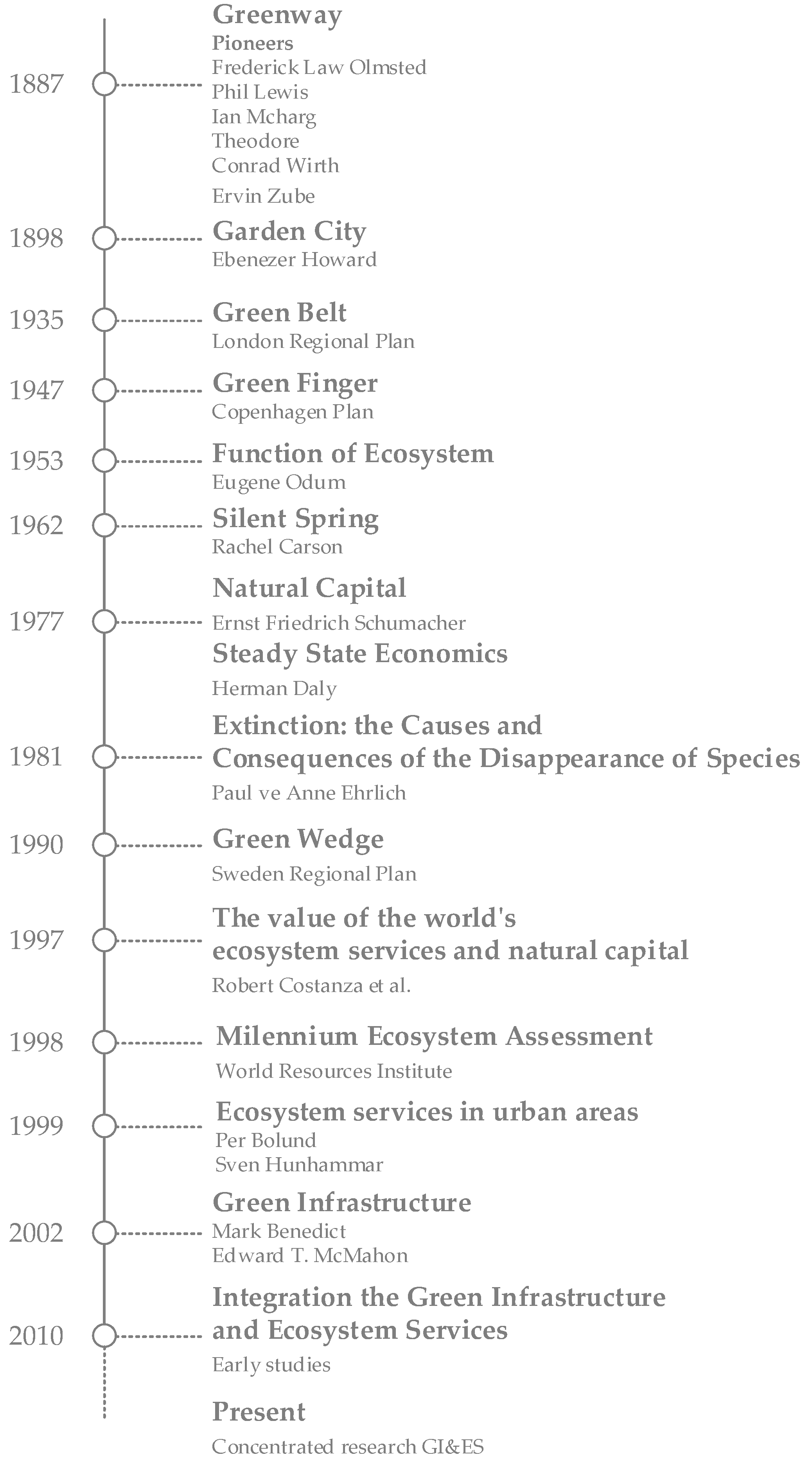
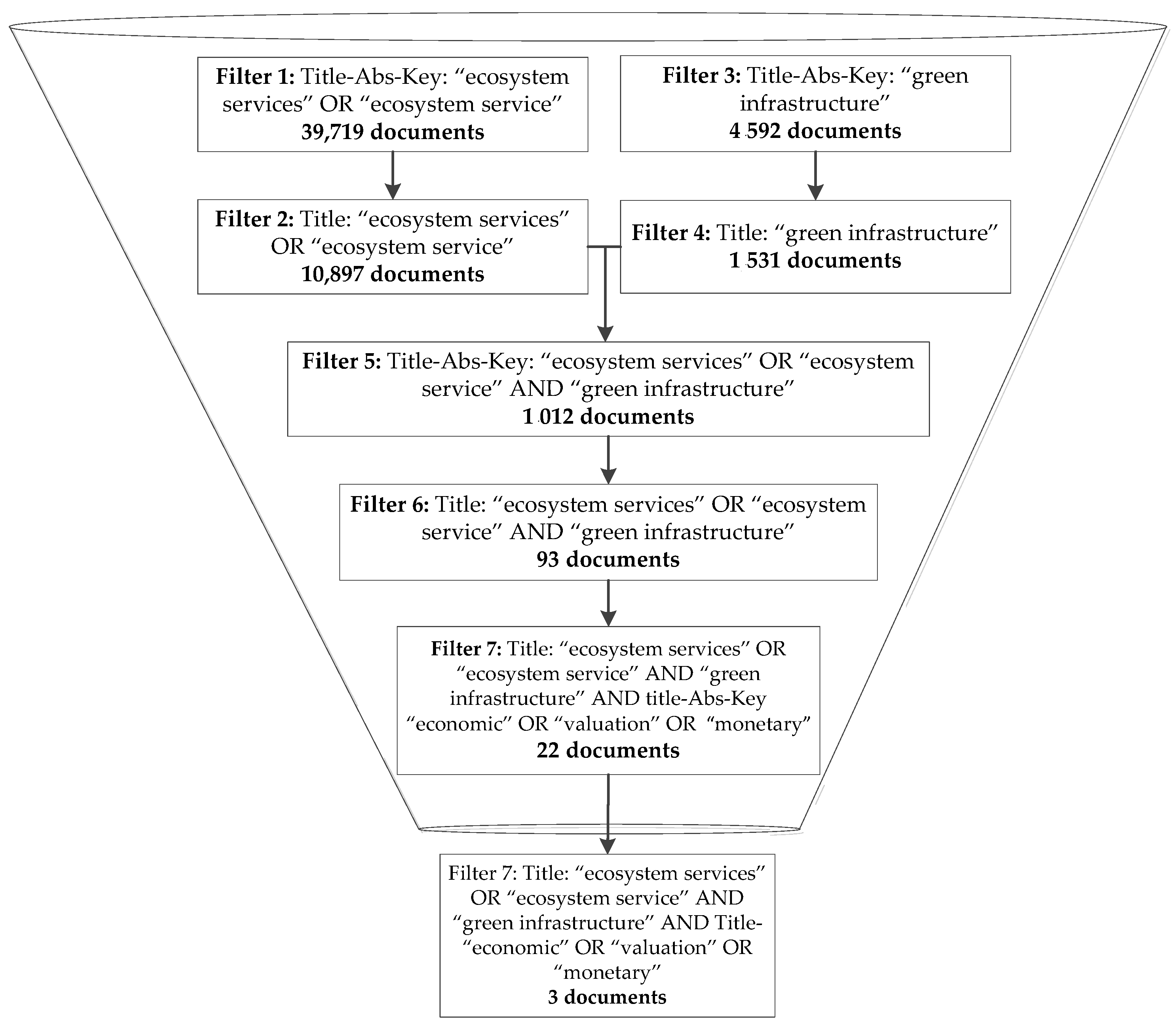
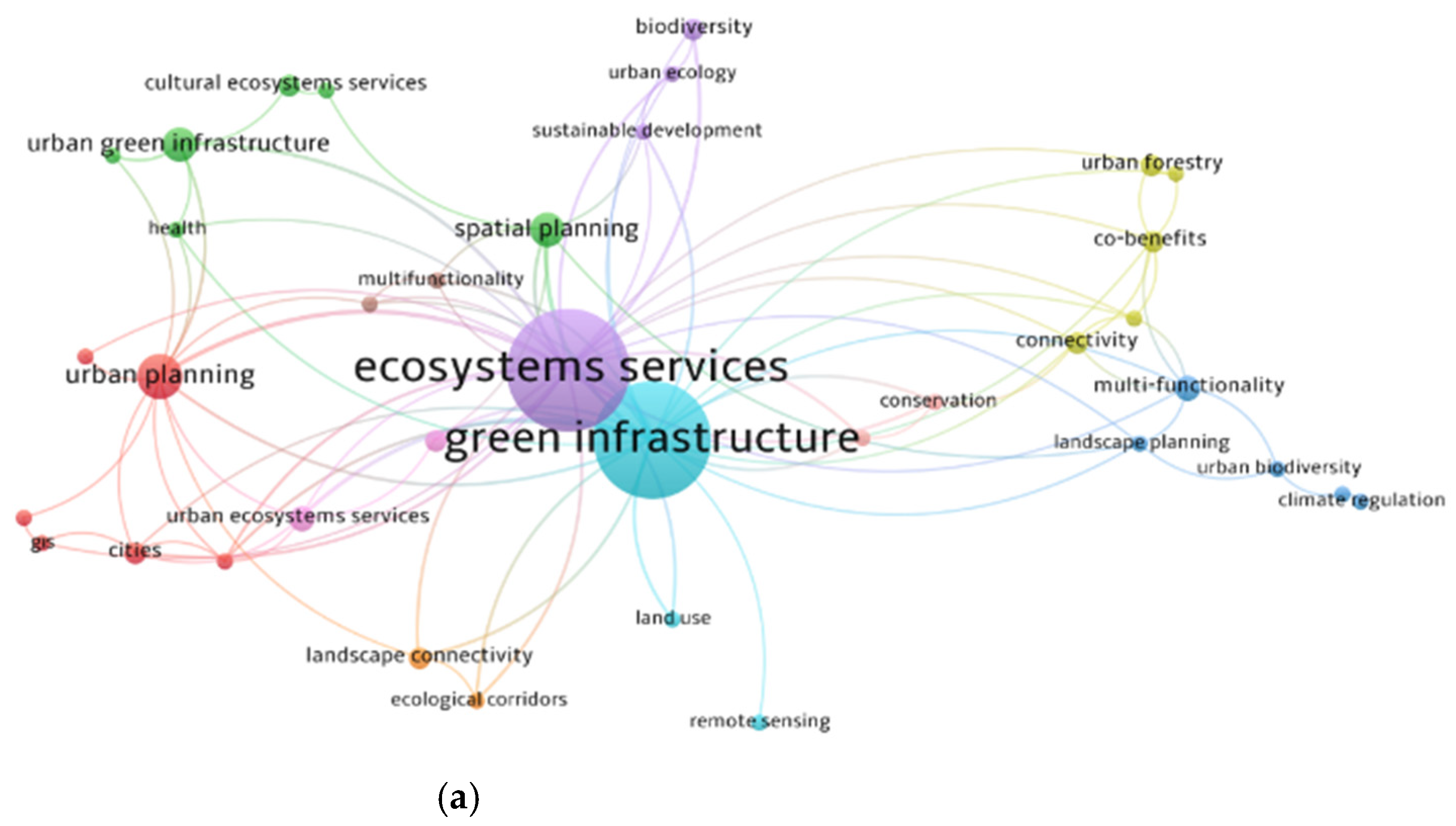
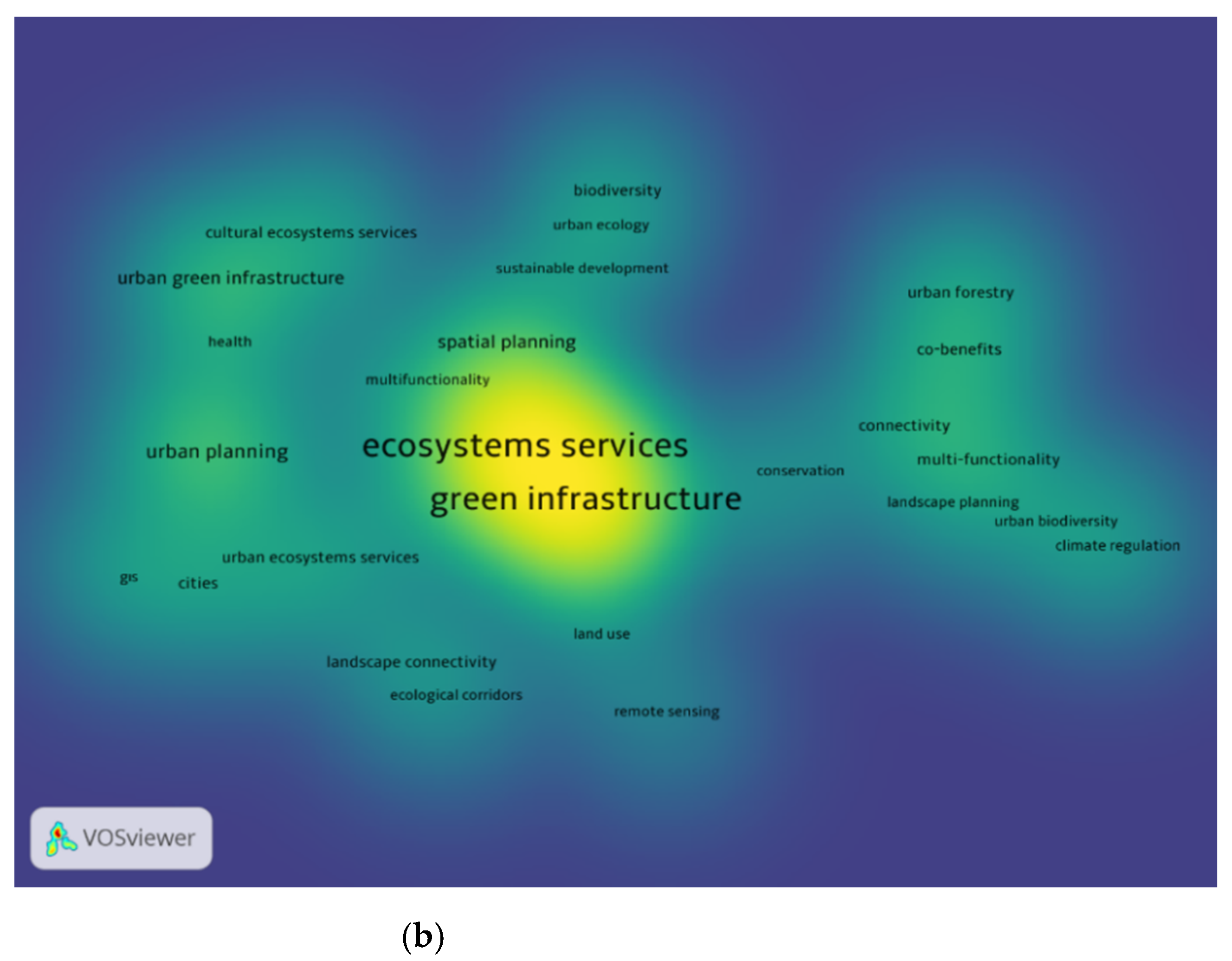
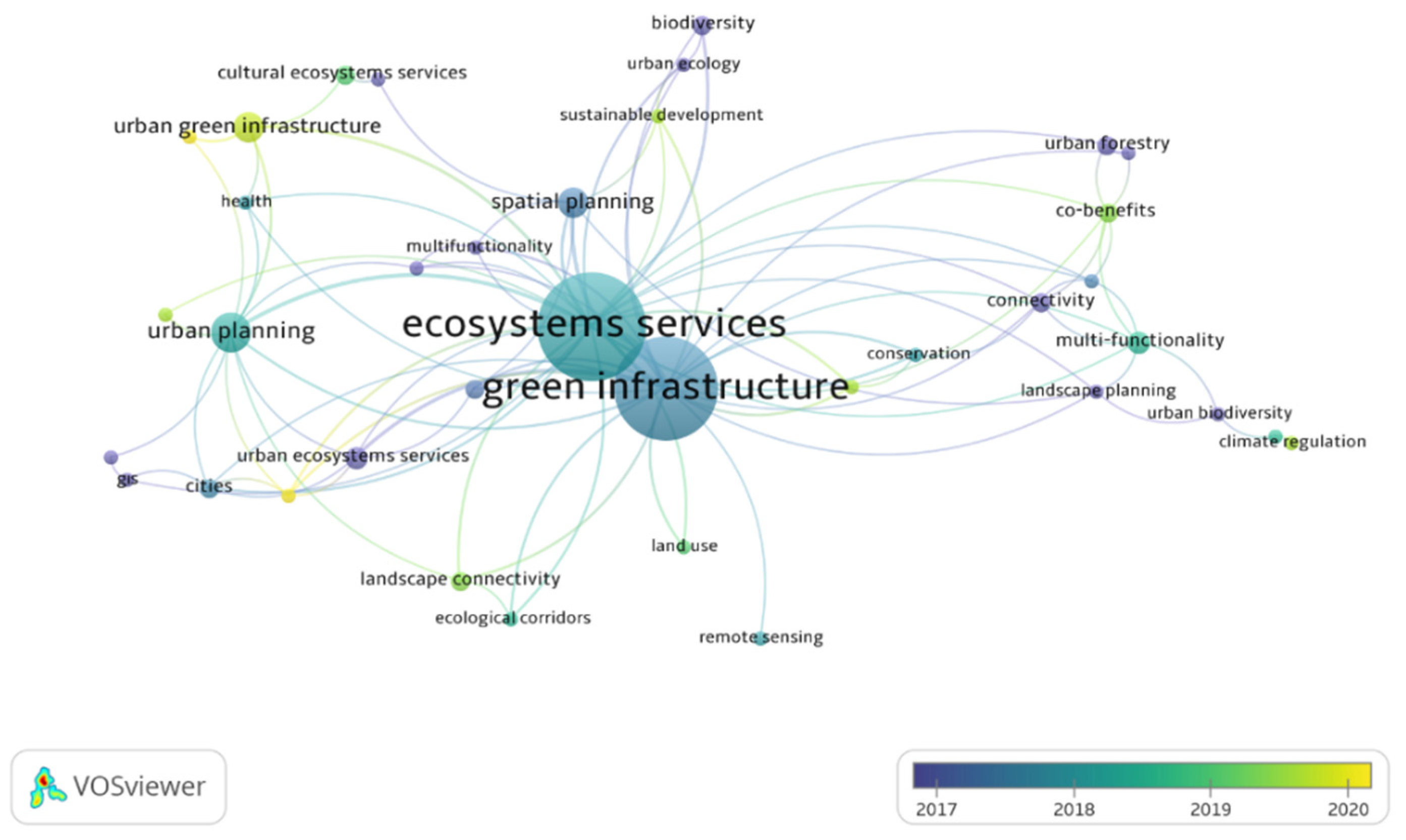
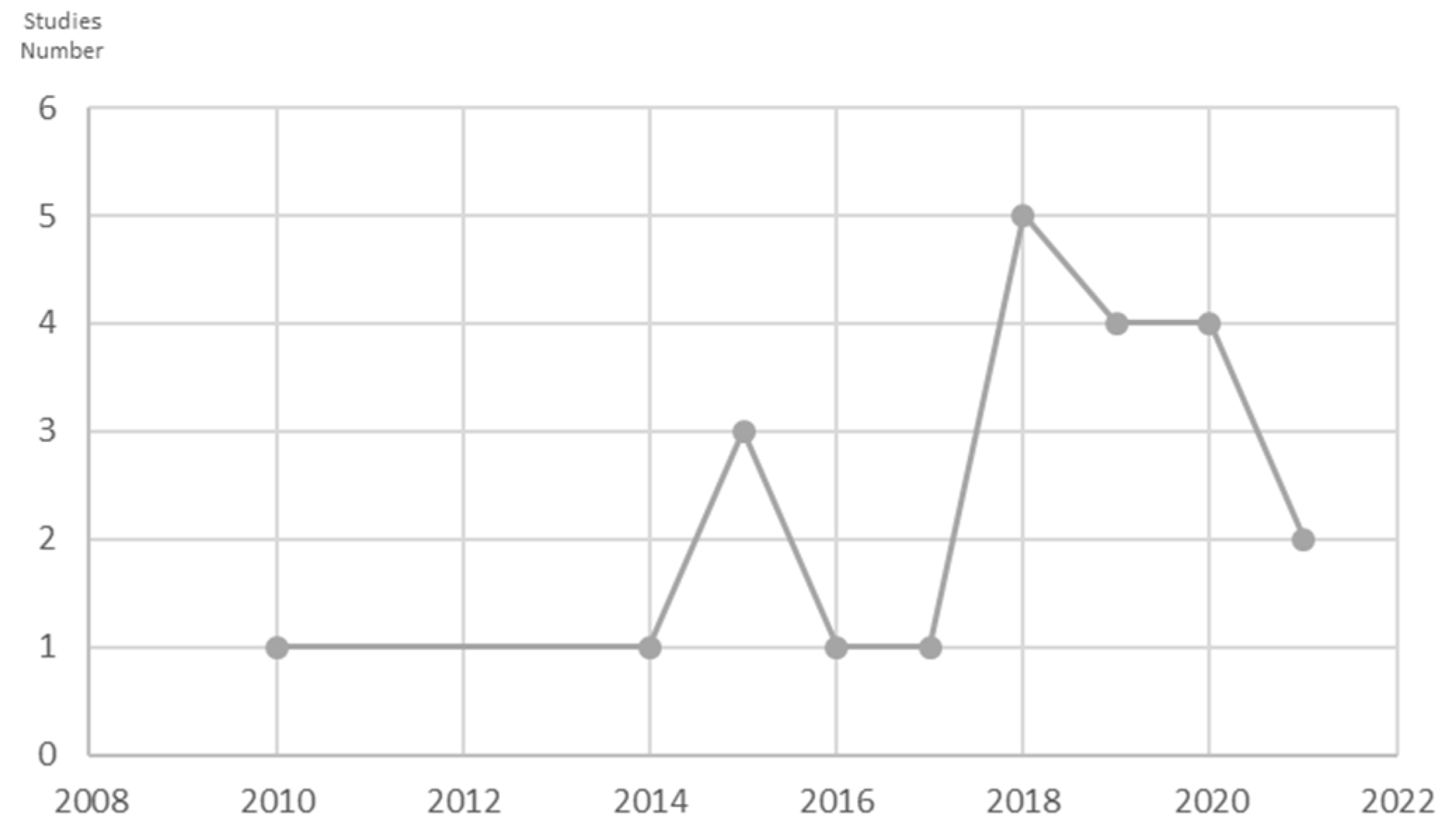
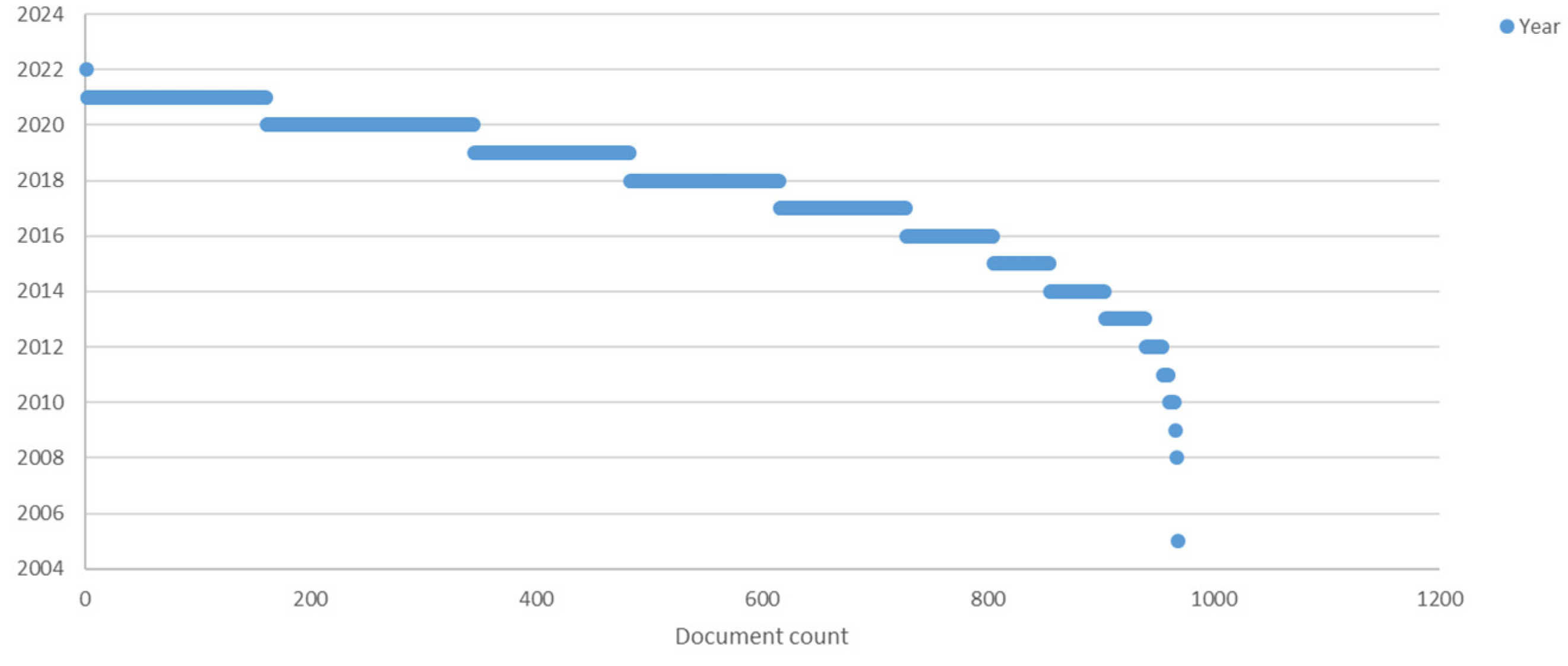
| Field | Applied Filter | Field | Applied Filter |
|---|---|---|---|
| Filter1 | Filter3 | ||
| Keyword | “ecosystem services” OR “ecosystem service” | Keyword | “green infrastructure” |
| Search within | Title, abstract, keywords | Search within | Title, abstract, keywords |
| Time | to 2021 | Time | to 2021 |
| Database | Scopus | Database | Scopus |
| Result | 39,719 documents | Result | −4592 documents |
| Filter 2 | Filter 4 | ||
| Keyword | “ecosystem services” OR “ecosystem service” | Keyword | “green infrastructure” |
| Search within | Title | Search within | Title |
| Time | to 2021 | Time | to 2021 |
| Database | Scopus | Database | Scopus |
| Result | −10,897 documents | Result | 1531 documents |
| Filter 5 | |||
| Keyword | “ecosystem services” OR “ecosystem service” AND “green infrastructure” | ||
| Search within | Title, abstract, keywords | ||
| Time | to 2021 | ||
| Database | Scopus | ||
| Result | 1012 documents | ||
| Filter 6 | |||
| Keyword | “ecosystem services” OR “ecosystem service” AND “green infrastructure” | ||
| Search within | Title | ||
| Time | to 2021 | ||
| Database | Scopus | ||
| Result | 93 documents | ||
| Filter 7 | |||
| Keyword | Title: “ecosystem services” OR “ecosystem service” AND “green infrastructure” AND title-abs-key: “economic” OR “valuation” OR “monetary” | ||
| Search within | Title and title-abs-key | ||
| Time | to 2021 | ||
| Database | Scopus | ||
| Result | 22 documents | ||
| Filter 8 | |||
| Keyword | Title: “ecosystem services” OR “ecosystem service” AND “green infrastructure” AND Title: “economic” OR “valuation” OR “monetary” | ||
| Search within | Title | ||
| Time | to 2021 | ||
| Database | Scopus | ||
| Result | 3 documents | ||
Publisher’s Note: MDPI stays neutral with regard to jurisdictional claims in published maps and institutional affiliations. |
© 2022 by the author. Licensee MDPI, Basel, Switzerland. This article is an open access article distributed under the terms and conditions of the Creative Commons Attribution (CC BY) license (https://creativecommons.org/licenses/by/4.0/).
Share and Cite
Ersoy Mirici, M. The Ecosystem Services and Green Infrastructure: A Systematic Review and the Gap of Economic Valuation. Sustainability 2022, 14, 517. https://doi.org/10.3390/su14010517
Ersoy Mirici M. The Ecosystem Services and Green Infrastructure: A Systematic Review and the Gap of Economic Valuation. Sustainability. 2022; 14(1):517. https://doi.org/10.3390/su14010517
Chicago/Turabian StyleErsoy Mirici, Merve. 2022. "The Ecosystem Services and Green Infrastructure: A Systematic Review and the Gap of Economic Valuation" Sustainability 14, no. 1: 517. https://doi.org/10.3390/su14010517
APA StyleErsoy Mirici, M. (2022). The Ecosystem Services and Green Infrastructure: A Systematic Review and the Gap of Economic Valuation. Sustainability, 14(1), 517. https://doi.org/10.3390/su14010517






